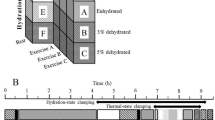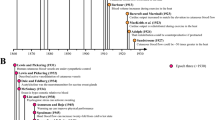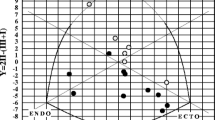Abstract
Two methods have been proposed previously for evaluating thermoregulatory responses to isolated core temperature perturbations. One involves clamping skin temperature at 28°C by water immersion and elevating core temperature by exercise. In the other, core temperature is reduced by central venous infusion of cold fluid while skin temperature is kept constant near 36°C. The sweating-to-shivering temperature range determined using the first protocol is ≈0.6±0.2°C, but is 1.4±0.6°C using the second. The authors tested the hypothesis that the disparity results from an exercise-induced reduction in the sweating threshold. The sweating threshold was determined three times each in six men, with skin temperature kept constant (36.5–37.0°C) throughout. The first threshold (control) was in response to gradual core hyperthermia that resulted from a skin temperature sufficiently high to prevent dissipation of metabolic heat. The second threshold (exercise) was in response to exercise-induced hyperthermia, and followed a period of core cooling (≈ 1°C) induced by central venous infusion of cold lactated Ringer's solution. The purpose of the central venous cooling was to reduce core temperature to a level well below the sweating threshold. The third threshold (recovery) again resulted from a skin temperature sufficiently high to prevent dissipation of metabolic heat. The control sweating threshold was 0.7±0.2°C greater than during exercise (P<0.01), but virtually identical to that during recovery. Since the control and recovery thresholds were similar, hyperhydration (necessary in this protocol) appears not to have influenced sweating thresholds. Our results thus indicate that exercise per se reduces the sweating threshold sufficiently to explain reported differences in the sweating-to-shivering range.
Similar content being viewed by others
References
Benzinger TH, Pratt AW, Kitzinger C (1961) The thermostatic control of human metabolic heat production. Proc Natl Acad Sci USA 47:730–739
Bissonnette B, Sessler DI, LaFlamme P (1989) Intraoperative temperature monitoring sites in infants and children and the effect of inspired gas warming on esophageal temperature. Anesth Analg 69:192–196
Buono MJ, Sjoholm NT (1988) Effect of physical training on peripheral sweat production. J Appl Physiol 65:811–814
Conway JM, Norris KH, Bodwell CE (1984) A new approach for the estimation of body composition: Infrared interactance. Am J Clin Nutr. 40:1123–1130
Fortney SM, Nadel ER, Wenger CB, Bove JR (1981) Effect of blood volume on sweating rate and body fluids in humans. J Appl Physiol 51:1594–1600
Havenith G, Midendorp H van (1990) The relative influence of physical fitness, acclimatization state, anthropometric measures and gender on individual reactions to heat stress. Eur J Appl Physiol 61:419–427
Hemingway A, Price WM (1968). The autonomic nervous system and regulation of body temperature. Anesthesiology 29:693–701
Johnson JM, Park MK (1981) Effect of upright exercise on threshold for cutaneous vasodilation and sweating. J Appl Physiol 150:814–818
Kellogg DL, Johnson JM, Kosiba WA (1991) Control of internal temperature threshold for active cutaneous vasodilation by dynamic exercise. J Appl Physiol 71:2476–2482
Kurz A, Plattner O, Sessler DI, Huemer G, Redl G, Lackner F (1993) The threshold for thermoregulatory vasoconstriction during nitrous oxide/isoflurane anesthesia is lower in elderly than young patients. Anesthesiology 79:465–469
Libert JP, Candas V, Vogt JJ (1979) Effect of rate of change in skin temperature on local sweating rate. J Appl Physiol 47:306–311
Lopez M, Sessler DI, Walter K, Emerick T, Ozaki M (1994) Rate and gender-dependence of the sweating, vasoconstriction, and shivering thresholds in humans. Anesthesiology 80:780–788
Lund CC, Browder NC (1944) The estimation of areas of burns. Surg Gynecol Obstet 79:352–358
Mekjavic IB, Sundberg CJ, Linnarsson D (1991) Core temperature “null zone”. J Appl Physiol 71:1289–1295
Mercer JB, Jessen C (1980) Thermal control of respiratory evaporative heat loss in exercising dogs. J Appl Physiol 49:979–984
Mittleman KD, Mekjavic IB (1991) Contribution of core cooling rate to shivering thermogenesis during cold water immersion. Aviat Space Environ Med 62:842–848
Nadel ER, Cafarelli E, Roberts MF, Wenger CB (1979) Circulatory regulation during exercise in different ambient temperatures. J Appl Physiol 46:430–437
Roberts MF, Wenger CB, Stolwijk JAJ, Nadel ER (1977) Skin blood flow and sweating changes following exercise training and heat acclimation. J Appl Physiol 43:133–137
Rowell LB (1981) Active neurogenic vasodilation in man. In: Vanhoutte PM, Leusen I (eds) Vasodilatation. Raven, New York, pp 1–17
Seckendor, R, Randall WC (1961) Thermal reflex sweating in normal and paraplegic man. J Appl Physiol 16:796–800
Sessler DI, Moayeri A (1990) Skin-surface warming: Heat flux and central temperature. Anesthesiology 73:218–224
Sessler DI, Moayeri A, Støen R, Glosten B, Hynson J, McGuire J (1990) Thermoregulatory vasoconstriction decreases cutaneous heat loss. Anesthesiology 73:656–660
Stolwijk JAJ, Nadel ER (1973) Thermoregulation during positive and negative work exercise. Fed Proc 32:1607–1613
Tam HS, Darling RC, Cheh HY, Downey JA (1978) Sweating response:a means of evaluating the set-point theory during exercise. J Appl Physiol 45:451–458
Tankersley CG, Smolander J, Kenney WL, Fortney SM (1991) Sweating and skin blood flow during exercise:Effects of age and maximal oxygen uptake. J Appl Physiol 71:236–242
Wagner JA, Robinson S, Marino RP (1974) Age and temperature regulation of humans in neutral and cold environments. J Appl Physiol 37:562–565
Washington DE, Sessler DI, McGuire J, Hynson J, Schroeder M, Moayeri A (1992) Painful stimulation minimally increases the thermoregulatory threshold for vasoconstriction during enflurane anesthesia in humans. Anesthesiology 77:286–290
Washington D, Sessler DI, Moayeri A, Merrifield B, Prager M, McGuire J, Belani K, Hudson S, Schroeder M (1993) Thermo-regulatory responses to hyperthermia during isoflurane anesthesia in humans. J Appl Physiol 74:82–87
Wenger CB, Roberts MF, Stolwijk JJA, Nadel ER (1975) Forearm blood flow during body temperature transients produced by leg exercise. J Appl Physiol 38:58–63
Wurster RD, McCook RD (1969) Influence of rate of change in skin temperature on sweating. J Appl Physiol 27:237–240
Wyss CR, Brengelmann GL, Johnson JM, Rowell LB, Silverstein D (1975) Altered control of skin blood flow at high skin and core temperatures. J Appl Physiol 38:839–845
Author information
Authors and Affiliations
Rights and permissions
About this article
Cite this article
Lopez, M., Sessler, D.I., Walter, K. et al. Reduced sweating threshold during exercise-induced hyperthermia. Pflugers Arch. 430, 606–611 (1995). https://doi.org/10.1007/BF00386153
Received:
Revised:
Accepted:
Issue Date:
DOI: https://doi.org/10.1007/BF00386153




